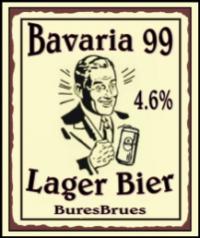Edited by KenLenard, 13 November 2014 - 05:32 PM.

Quick carb question...
#1

Posted 13 November 2014 - 05:31 PM
#2

Posted 13 November 2014 - 05:46 PM
Yeah, why wouldn't it? Did you try it again today?
#3

Posted 13 November 2014 - 05:46 PM
Ken, I assume this beer is really clear. Just hit it with 40 PSI or so and shake for a minute or two. Then try it. I've seen my son carb a keg in just a few minutes doing that. It can be done if you're in a hurry.
#4

Posted 13 November 2014 - 05:57 PM
Ken, I assume this beer is really clear. Just hit it with 40 PSI or so and shake for a minute or two. Then try it. I've seen my son carb a keg in just a few minutes doing that. It can be done if you're in a hurry.
This is what I typically do.... but then again I'm very impatient.
#5

Posted 13 November 2014 - 06:03 PM
This is what I typically do.... but then again I'm very impatient.
Eh, he's usually more patient but sometimes in the biz it happens.
#6

Posted 13 November 2014 - 07:17 PM
I'll chill the keg, crank up the pressure to around 30 and shake the bejezus out of it for about 10-15 min, let it sit for about 30 min or so. I'll then bleed off the head pressure and turn the gas back on to around 10 PSI (What I normally pour at) and let it sit in the fridge over night. The next day it's ready to go. never an issue.
#7

Posted 13 November 2014 - 07:45 PM
#8

Posted 13 November 2014 - 10:33 PM
Okay, so a confession/explanation: I have always been able to force carb this way and I have always had success doing it so I never really put a lot more thought into it and I certainly never expanded my knowledge on the subject. It's always been a "connect this and turn this and then wait this long... and then a miracle occurs... and then you have carbed beer".
I get what's happening but I do it by the numbers every time so when the numbers don't line up, I have to think about it. Like... if the beer is sitting with 10psi of pressure on it, when does the beer stop absorbing CO2? I assume it stops absorbing CO2 at 10psi earlier than it would if the CO2 was at 25psi. Anyway, I just tapped a glass of this beer and it actually came out excellent. Remember that I have no idea how long it sat on the gas before that original tank went out. Apparently the addition 12-13 hours was good. Cheers peeps.
It will absorb CO2 until it reaches equilibrium. Assuming temperature is being held constant for all of your beers, keeping any of your kegs set to a constant pressure (10 psi in your case) will cause them to carb to the same number of volumes, The time it takes to reach that might vary, but that's where it will end up. If you are at 40 degrees and 10 psi, you will eventually have 2.3 volumes.
The thing you lose this time is knowing when your beer will be fully carbed, but within a week or so is a safe bet. your normal system just sped the process up.
#9

Posted 14 November 2014 - 07:41 AM
Thanks Dave. I feel like I know how to do all of this but when I'm talking with someone who knows more about it, I realize how much I don't know. I say that the beer absorbs the CO2 but I'm corrected by someone saying that the "CO2 dissolves into the beer". Okay, got it. I also know that people connect a flat, cold keg to a regulator set at 10psi and then just wait a week for carb to form. I thought of that when I moved it from the 25psi tank and into the serving fridge with the tank set to 10psi... if it was slightly undercarbed, being connected to that 10psi tank would continue to carb it. All good! Cheers.It will absorb CO2 until it reaches equilibrium. Assuming temperature is being held constant for all of your beers, keeping any of your kegs set to a constant pressure (10 psi in your case) will cause them to carb to the same number of volumes, The time it takes to reach that might vary, but that's where it will end up. If you are at 40 degrees and 10 psi, you will eventually have 2.3 volumes. The thing you lose this time is knowing when your beer will be fully carbed, but within a week or so is a safe bet. your normal system just sped the process up.
#10

Posted 14 November 2014 - 08:32 AM
Considering the weight, I'd just like to see one of my brothers connect a corny and "shake the hell out of it." ![]()
I've heard of 'rolling' the cornys to get them up to carb fast but I've also read cautions about beer getting into the regulator. Any advise on this?
#11

Posted 14 November 2014 - 08:58 AM
Thanks Dave. I feel like I know how to do all of this but when I'm talking with someone who knows more about it, I realize how much I don't know. I say that the beer absorbs the CO2 but I'm corrected by someone saying that the "CO2 dissolves into the beer". Okay, got it. I also know that people connect a flat, cold keg to a regulator set at 10psi and then just wait a week for carb to form. I thought of that when I moved it from the 25psi tank and into the serving fridge with the tank set to 10psi... if it was slightly undercarbed, being connected to that 10psi tank would continue to carb it. All good! Cheers.
I forget the exact chemistry, but CO2 ends up combining with water to form carbonic acid, which is dissolved in the beer. Absorbed or absorbed is splitting hairs.
You've got a simple repeatable system that gets the results you want pretty reliably. Stick with it. Most other systems change how quickly the beer gets carbed, but not the level of carbonation. Ultimately, a certain pressure at a certain temperature will lead to a specific volume of C02 in the beer.
#12

Posted 14 November 2014 - 09:28 AM
My issue continues to be excessive foam, even when doing something similar to what Ken does.
It's embarrassing when a glass is half foam. When you "burp" the keg before setting the serving pressure, do you burp it all the way until no more gas comes out of the relief valve???
#13

Posted 14 November 2014 - 09:42 AM
Yes, I do. Then set your reg to serving pressure and reconnect it.My issue continues to be excessive foam, even when doing something similar to what Ken does. It's embarrassing when a glass is half foam. When you "burp" the keg before setting the serving pressure, do you burp it all the way until no more gas comes out of the relief valve???
#14

Posted 14 November 2014 - 08:44 PM
#15

Posted 15 November 2014 - 07:29 AM
I shake the keg at 25 psi for a few minutes and then let it cool at 25 psi for 24 or so hours. I then burp the keg and set it to 12 psi for serving. That usually does the trick.
Trying to tap it, right after shaking it, always yields a lot of foam.
#16

Posted 15 November 2014 - 09:28 PM
I shake the keg at 25 psi for a few minutes and then let it cool at 25 psi for 24 or so hours. I then burp the keg and set it to 12 psi for serving. That usually does the trick.
Trying to tap it, right after shaking it, always yields a lot of foam.
This... it definitely needs at the very least 4 hours to calm down and not foam to beat all.
0 user(s) are reading this topic
0 members, 0 guests, 0 anonymous users













